Experimental Determination of Relativistic Electron Interaction Parameters of Standard Inorganic Salts of d-block Elements
S. Ramesh Babu1 , N.M.Badiger2Abstract: Electron interaction parameters of 16 standard inorganic salts of d-block elements are determined by measuring their mass stopping power by recording the spectrum of electrons incident on and transmitted by them. 137Cs and 207Bi internal conversion sources are used as the source of 614 keV and 942 keV internal conversion electrons and Si (Li) detector coupled to an 8K multichannel analyzer as the spectrometer to record these spectra. The effective atomic number of these salts for 614 keV and 942 keV electron interactions are determined by substituting their measured mass stopping power in the semi empirical relation between the mass stopping power and atomic number. This semi empirical formula is arrived at by plotting and fitting the measured mass stopping power of Al, Cu, Ag, Sn, Au and Pb against their atomic number. The experimental results are compared with the theoretical values of effective atomic number for electron and photon interaction for organic and inorganic samples. It is observed that effective atomic number of inorganic salts is the same for both electron and photon interactions in the energy range of current study. Stopping cross section is derived from mass stopping power and effective electron density from the effective atomic number and their dependence on effective atomic number are studied.
Keywords: Internal conversion electron, Interaction parameters, Mass stopping power, Effective atomic number, Effective electron density.
I. INTRODUCTION
Electron interaction with matter is of high importance among other radiation interaction with matter. It is mainly because, all type of radiation interactions results in release of electrons which interacts with the matter to cause physical, chemical and biological damages. Hence the measurement of interaction parameters of electrons like Mass Stopping Power (MSP), Energy Loss Straggling (ELS), Stopping Cross Section (SCS), Effective atomic Number (Zeff) and Effective electron density (Ne) became a necessary ingredient for many parts of basic science, medical applications and technological applications.
As mentioned in our earlier paper [1], many authors have determined photon interaction parameters for various biological samples, chemical compounds and polymers. Singh et al., [2] has measured the interaction parameters of 123 keV-1132 keV photons with different compounds. They found that the variation in mass attenuation coefficient is mainly due to the variations in the energy and hence in photon interaction processes rather than the variation in properties of matter. Icelli et al., [3] has measured the interaction parameter of 15.74–40.93 keV photons with some boron compounds and trommel sieve waste using mixture rule and compared their results with the theory. Niranjan et al., [4] has estimated the interaction parameters of 1keV -105 MeV photons with oxides of lanthanides using the mass attenuation coefficient from WinXCom and mass energy absorption coefficient from Hubbell and Seltzer. Yüksel and Kurudirek [5] have measured the
interaction parameters of 59.54keV photons in 21 different compounds, using a narrow beam good geometry set-up and compared their results with the theory.
Several investigators [6-10] have studied the charged particle interaction parameters in many organic materials using the mass stopping power downloaded from ESTAR web database [11] as detailed in our earlier paper. Recently the MSP and ELS of ions in different oxides such as ZnO, Al2O3, HfO2, ZrO2, TiO2 and Ta2O5 have been measured [12, 13]. The ELS of alpha particles in varying thickness of Al, Ti and Ni metallic foils have also been measured to test the existing theory [14]. The energy losses of Li and C ions in aluminium foils have been studied to understand collisional energy loss and charge exchange straggling [15].
However, the experimental study of interaction parameters of medium energy electrons in biological and non-biological absorbers is very rare. There is only theoretical estimation of electron interaction parameters in biological and nonbiological absorbers. In our earlier paper [16] we have measured MSP of inorganic elements and derived a semi empirical relation between the MSP and Z for Z =10-82. In the present research work, we have experimentally determined the electron interaction parameters for relativistic electrons of energies 614 and 942 keV in inorganic salts of d block elements using their measured MSP in the above semi empirical relation. To the best of our knowledge, this is the first attempt to understand experimentally the interaction of relativistic electrons in inorganic materials.
Inorganic salts dissociate to release ions which are used for many important functions of the body like neural transmission, pH regulation etc. As, d-block elements are in between s-block and p-block elements in their position and properties, they are the best representative of entire periodic table. Depending on their non-metallic part, they can be broadly classified into oxides, nitrides, sulphides and halides. As the MSP-Z relation is different for Z < 10 and for Z >10, we dropped down the oxides and nitrides containing nitrogen and oxygen of Z<10. We by measuring the MSP determined all the interaction parameters of sulphides and halides of commonly used d-block elements for 614keV and 942 keV electron interactions.
II. THEORY
Interaction parameters are the parameters providing essential information about the interactions. The five important interaction parameters of electron interaction are:
1. Mass Stopping Power, the energy loss per unit thickness of the sample. It can be determined accurately by measuring the absorber thickness, the incident and transmitted spectra. As MSP is easily measurable, it is often used to derive all other interaction parameters.
2. Energy Loss Straggling is the fluctuation of the energy loss around its mean value. It can be determined from the FWHM of the incident and transmitted spectra. As it demands high degree of target thickness uniformity and accurate spectral fitting it is used mainly in very large scale integration modelling and programs to create analytic functions of ion implantation distributions.
3. Stopping Cross Section is the energy lost per atom of the sample. SCS has several applications in research fields like radiobiology, medical physics and electron transport modelling etc. SCS is derived from MSP as below:
If the sample contains ni number of ith element of atomic weight Ai then,
4. Effective atomic number, Zeff is a weighted arithmetic mean of the atomic number of the constituent atoms with the weighing factor accounting for the type of radiation, material and interaction. Hence it is widely used in radiation studies, particularly to characterize the interaction processes in composite materials. It can be determined accurately from the knowledge of MSP of the sample and MSP-Z relation of pure elements in the energy range of interest. It can also be determined with fairly good accuracy by adopting the following formula of direct method used for photon interactions [17].
∑ ( ) ∑ ( ) (4)
Where (MSP)i, Ai and Fi are the MSP, mass number and molar fraction of the element “i” in the sample.
5. Effective electron density, Ne is the number of electrons per gram corresponding to the Zeff of the sample. It is used in radio diagnosis to decide the contrast and in nuclear medicine to estimate the emitted radiation Ne is derived from effective atomic number as below.
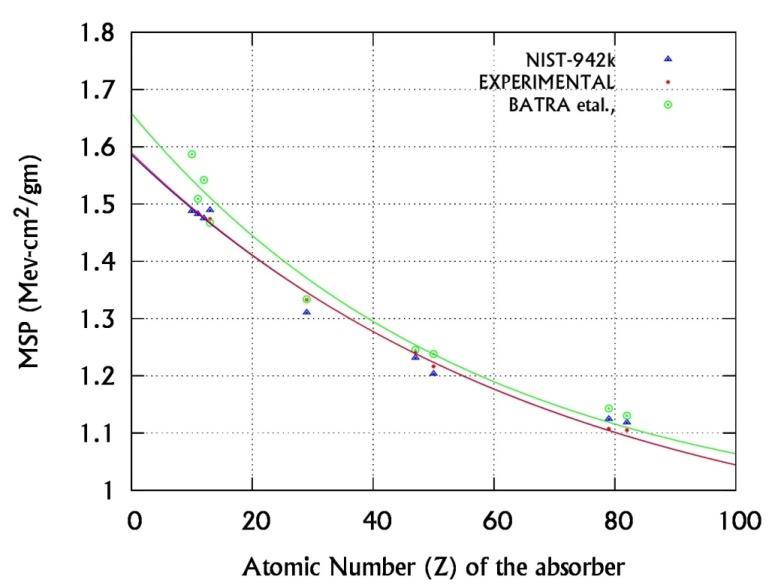
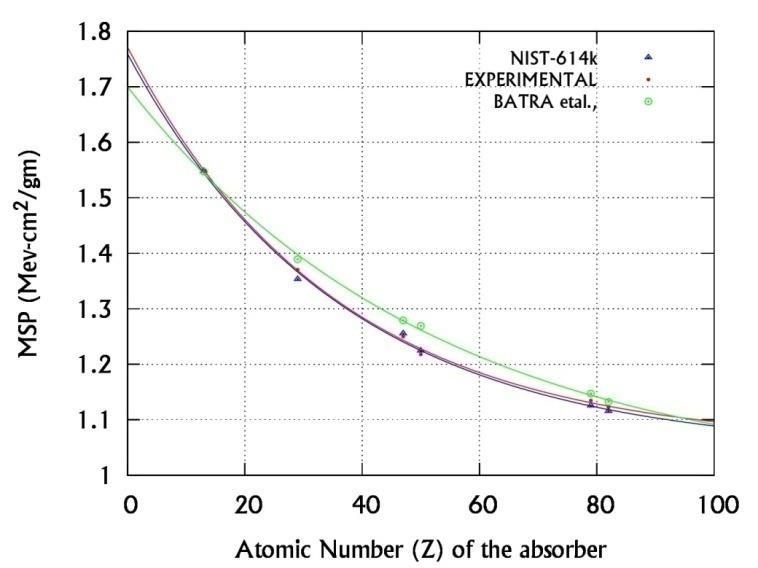
(5)
The energy absorption in any composite material can be obtained using well established formulae, if their interaction parameters namely Zeff and effective electron density are known. In our earlier paper [16] we have established that the variation of MSP of pure elements, against their atomic number can be represented by a first order exponential decay as ( ) ⁄ ( )
Where Z >10 and A0, A1 & B are the energy dependent fitting parameters as shown in table-I. The correctness of this formula is verified [16] by calculating and comparing the MSP of all elements with the ESTAR [11] and Batra et al., [18] values for Z=10 to 82. The curve fitting process is as shown in figure-1, where we have measured and used the MSP of Al, Cu, Ag, Sn, Au and Pb to obtain the fitting parameters A0, A1 and B.
TABLE I: Fitting parameters for the incident energies of 614 & 942 keV
III. EXPERIMENTAL ARRANGEMENT
The experimental arrangement to measure the MSP of the relativistic electrons is as detailed in our earlier paper [19]. In nutshell, figure-2 is the schematic representation of the experimental setup with two collimators C1 & C2 between which the sample is to be placed. Here the labels LV, HV and MCA represent the Low voltage unit, High Voltage Unit and Multi Channel Analyzer respectively.
Fig.2- Experimental arrangement for measurement of the MSP
We have used 207Bi and 137CsIC source as the source of relativistic electrons. 207BiIC source used in this experiment is electroplated on a platinum foil and encapsulated in stainless steel of 1.52 cm outer diameter with 18.8 mg/cm2 thick beryllium window to prevent the source spilling and contamination. It emits 481.7, 555.4, 975.7 and 1049.4 keV IC electrons. After correcting for the attenuation by the beryllium window of the source and the air column between the source and detector, their effective energies will be 444, 519, 942 and 1016 keV respectively.
137Cs radioactive source emits 624.2 keV K shell internal conversion electrons. This source is covered with thin Mylar foil of thickness 1.2 mg/cm2 to avoid the source spilling and contamination. After correcting for this coverings & air attenuation between the source and the detector, the effective energy of the IC electrons becomes 614 keV.
The selection-grade NE Si (Li) detector used in this experiment has 0.2 cm depletion area and 15 cm2 active areas. Detector output is connected to an 8K MCA through a charge sensitive ORTEC preamplifier of charge sensitivity 15mV/MeV (Si eq ) and a delay line amplifier. The entire assembly is placed in a light tight box as in figure 2.
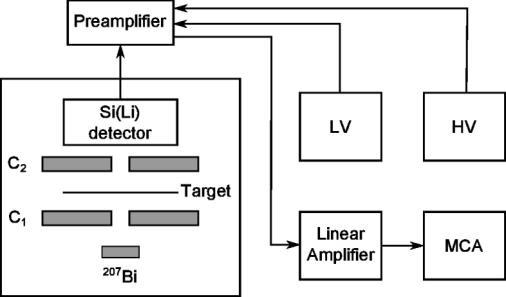
The absorbers are the inorganic salts of reagent grade. The samples are prepared by sandwiching a measured quantity of the finely powdered inorganic salt between two thin polythene films of negligible attenuation. The sample thickness is found using travelling microscope and a sensitive balance. Thickness uniformity of the sample is verified from the sharpness of the transmitted spectra.
IV. PROCEDURE
After checking for the stability of the spectrum over time, the 207 Bi spectrum with four peaks due to 444, 519, 942 and 1016 keV IC electrons is acquired without any material between the source and detector. All these four peaks are fitted to four EMG to get the channel number corresponding to peaks as in Fig 3. A plot of these corresponding to the peaks against their energies called the calibration graph of the spectrometer is shown as inset in figure-3. The calibration factor of the spectrometer is found to be (0.2996 ± 0.0009) keV/channel
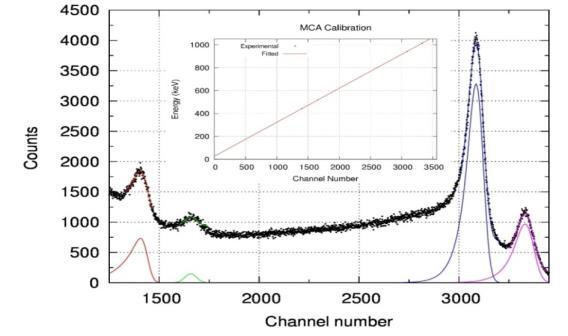
International Journal of Recent Research in Physics and Chemical Sciences (IJRRPCS)
Vol. 4, Issue 2, pp: (1-10), Month: October 2017 – March 2018, Available at: www.paperpublications.org
The incident and transmitted spectra of 137Cs are acquired without and with the sample between the collimator C1 and C2 Such spectra of different sulphides, chlorides, bromide-iodides are shown in figures 4 (a), (b) & (c)
From these spectra the Most Probable Energy (MPE) and hence the energy loss are obtained and used to evaluate their MSP of the sample. Thus evaluated MSP are substituted in the empirical relation (6) to determine the Zeff of sulphides and halides for 614keV electron interactions and presented in the table II. The SCS and Ne are computed from using the equations (1), (2), (3) and (5) and presented in the table III
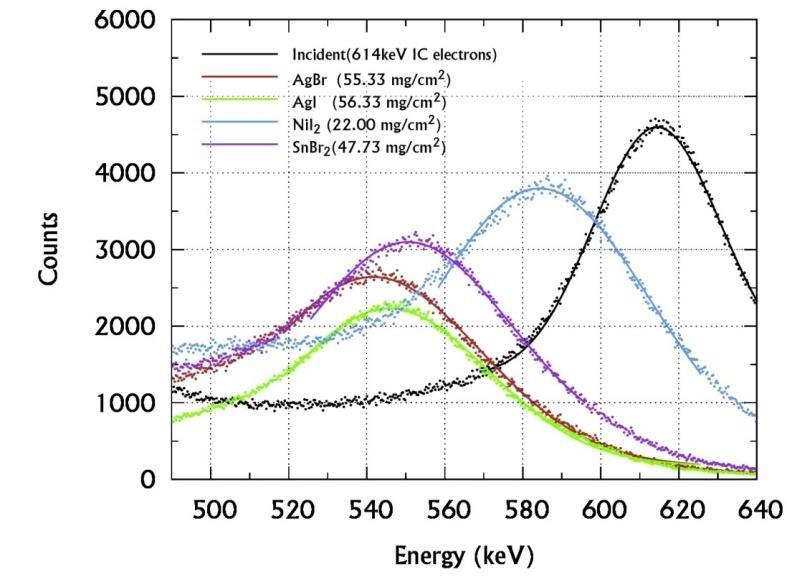
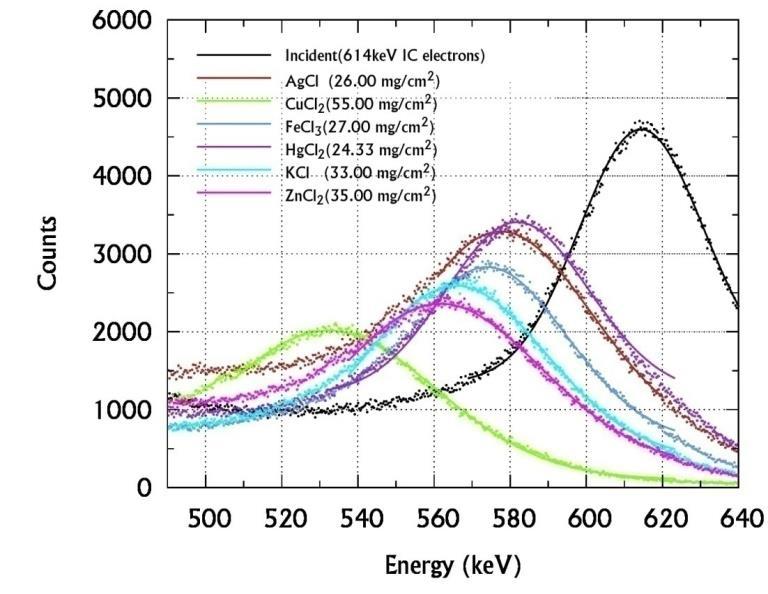
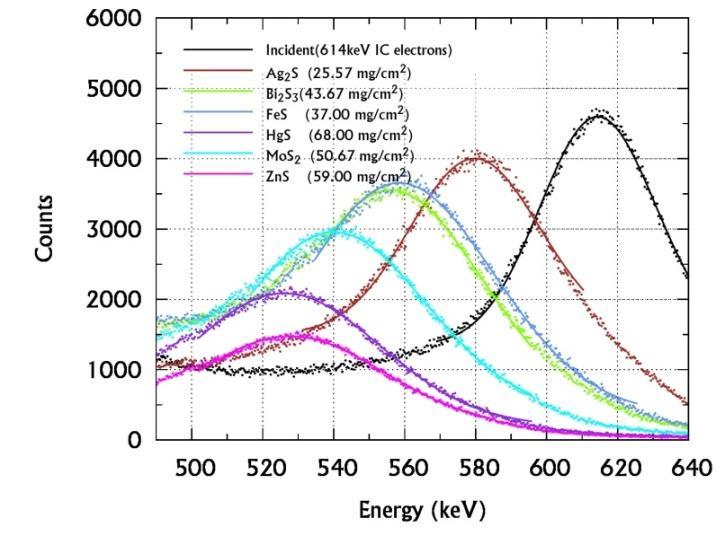
International Journal of Recent Research in Physics and Chemical Sciences (IJRRPCS)
Vol. 4, Issue 2, pp: (1-10), Month: October 2017 – March 2018, Available at: www.paperpublications.org
This study is repeated with 207Bi source to obtain all the above mentioned interaction parameters for the 942 keV electrons in sulphides, chlorides, bromides and iodides samples as presented in Tables-IV and V. Figures 5(a),(b) and (c) presents the EMG fitted spectra of 942 keV IC electrons incident on and transmitted through various sulphides, chlorides, bromides and iodides salts of d-block elements.
International Journal of Recent Research in Physics and Chemical Sciences (IJRRPCS)
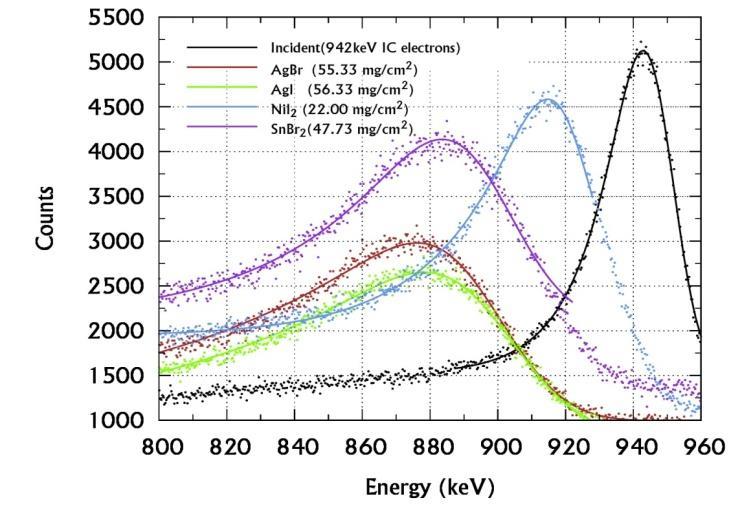
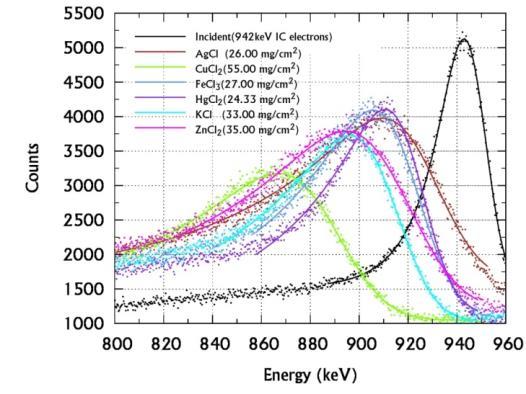

V. RESULTS AND DISCUSSION
The choice of Bi207 IC source follows the fact that, it emits wide ranges of IC electrons, all of which can be used simultaneously for the MCA calibration under the same environmental conditions to enhance the accuracy of the calibration. The data acquisition time is so chosen that the total count under each spectral peak is greater than 10,000 and hence the counting error is less than 1%.
In Table II and IV, we present the experimentally measured energy loss, MSP, Zeff for electron interaction and photon interaction of different inorganic salts of d block elements for 614 keV and 942 keV. We have also compared our measured Zeff for electron interactions with theoretical values calculated by direct method for both electron and photon interactions of the same energies. We notice that our measured values of Zeff for 614 keV and 942 keV IC electrons agree with the theoretical values within ±1% for all inorganic salts under investigations. It is observed further that in all cases except the mercuric salts Zeff,ei and Zeff,pi too agrees within ±2%. This is against the variation of ±7 % observed with organic compounds. This questions the variation of Zeff with type of radiation especially for the materials of atomic number greater than 10. Further experimental studies of more inorganic salts in this regard may confirm this conclusion. Table-III and V presents the derived interaction parameters for the relativistic electron interactions with the common inorganic salts of d-block elements. All these interaction parameters MSP, SCS, Aeff and Ne are found to vary linearly with their Zeff. The ratio Zeff/Aeff and hence Ne have a constant value of nearly 0.5 and 3x1023 electron /gm in all stable compounds as was the case in stable elements.
VI. CONCLUSIONS
We have measured the electron interaction parameters of representative d-block elements by measuring their MSP for 614 keV and 942 keV IC electrons. The effective atomic number is determined using the semi empirical formula devised by us to relate the MSP and Zeff of elements of Z > 10 [16]. Thus determined Zeff are compared with the theoretical Zeff values of electron and photon interactions computed using direct method. A good agreement within ±1-2% between the experimental Zeff,ei and theoretical Zeff,ei as well as Zeff,pi is observed. This agreement between Zeff,ei and Zeff,pi doubts the variation of Zeff with the type of radiation especially for materials of Z > 10. This result needs to be confirmed by further experimental investigations with more number of inorganic salts. We have also determined the derived interaction parameters namely Zeff/Aeff, Ne and SCS for electron interactions at 614 keV, 942 keV and 1016 keV. All these quantities show linear variation with Zeff for electron interaction.
Our energy range of measurements lies in the minimum ionization point region around which the variation in MSP and hence other interaction parameters are insignificant over a wide range of energies. Analysis of ESTAR (5) data shows a maximum of ±4% variation in MSP over the energy range between 500-750 keV and 750-2500 keV. As this statement holds well for all elements of Z = 1 to 98, MSP and SCS measured at 614 keV and 942 keV of this work can be used over the energy range 500-750 keV and 750-2500 keV within an accuracy of ±4%. As established by Prasad et al.,(10), Zeff is constant over a wide range of energy around 1- 10 MeV for electron interactions and hence the Zeff and Ne determined for 942 keV electrons in this work can be used at any energy of 1-10 MeV electron interactions.
REFERENCES
[1] S. Ramesh Babu,, M. M. Hosamani, S. Mirji, N. Badiger, Determination of Effective Atomic Number of Some Bimolecules for Electron Interaction , IOSR Journal of Applied Physics (IOSR-JAP) 8(III), 23 (2016). doi="10.9790/4861-0803032327"
[2] V. K. Singh, Rajinderjit Kaur, V. Kumar, Study of Effective Atomic Numbers and Mass Attenuation Coefficients In Some Compounds , Radiat. Phys. Chem. 47(4), 535 (1996). doi = "https://doi.org/10.1016/0969-806X(95)00057-5"
[3] O. Icelli, S. Erzeneoglu, R. Boncukcuoglu, Determination of Molecular, Atomic, Electronic Cross-Sections and Effective Atomic Number of Some Boron Compounds and TSW, Nuclear Instruments and Methods in Physics Research B 266, 3226 (2008), doi = "https://doi.org/10.1016/j.nimb.2008.04.009"
[4] R.S.Niranjan, B.Rudraswamy, N.Dhananjaya, Effective Atomic Number, Electron Density and Kerma of Gamma Radiation for Oxides of Lanthanides, Pramana- Journal of Physics 78(3), 451 (2012). doi="10.1007/s12043-0110247-4"
[5] Yuksel Ozdemir and Murat Kurudirek, A study of total mass attenuation co-efficients, effective atomic numbers and electron densities for various organic and inorganic compounds at 59.54 keV , Annals of Nuclear Energy 36, 1769 (2009). doi = https://doi.org/10.1016/j.anucene.2009.09.008
[6] M . L. Taylor, R. D. Franich, J. V. Trapp, P. N. Johnston, Electron Interaction with Gel Dosimeters: Effective Atomic Numbers for Collisional, Radiative and Total Interaction Processes , Radiation Research 171(1), 123 (2009). doi ="10.1667/RR1438.1"
[7] M. L. Taylor, Robust determination of effective atomic numbers for electron interactions with TLD-100 and TLD100H thermo luminescent dosimeters, Nuclear Instruments and Methods in Physics Research -B 269(8), 770(2011), doi ="10.1667/RR1438.1"
[8] K. Parthasaradhi, B. M. Rao, S. G. Prasad, Effective atomic numbers of biological materials in the energy region 1 to 50 MeV for photons, electrons and He ions , Medical Physics 16(4), 653 (1989). doi = “10.1118/1.596325”
[9] M. Kurudirek, T. Onaran, Calculation of effective atomic number and electron density of essential biomolecules for electron, proton, alpha particle and multi-energetic photon interactions , Radiation Physics and Chemistry 112, 125 (2015). doi = "https://doi.org/10.1016/j.radphyschem.2015.03.034"
International Journal of Recent Research in Physics and Chemical Sciences (IJRRPCS)
Vol. 4, Issue 2, pp: (1-10), Month: October 2017 – March 2018, Available at: www.paperpublications.org
[10] S. G. Prasad, K. Parthasaradhi, W. D. Bloomer, Effective atomic numbers of composite materials for total and partial interaction processes for photons, electrons, and protons , Medical Physics 24(6),883 (1997). doi = "10.1118/1.598001"L. Ma, Q. Chen, J. Xue, Y. Wang, A study of energy loss and straggling of MeV protons in biological samples , Radiation Measurements 43, Supp.1, S598 (2008). doi = "https://doi.org/10.1016/j.radmeas. 2008.04.063"
[11] `ESTAR, PSTAR and ASTAR: Computer Program for Calculation of Stopping Power and Range Tables for Electron, Proton and Helium Ions (version 1.2.3) (2005). URL=”http://physics.nist.gov/Star”
[12] S.P.Limandri, R.C.Fadanelli, M.Behar, et al. et al., Stopping cross sections of TiO2 for H and He ions , The European Physical Journal D 68(7), 194(2014). doi="10.1140/epjd/e2014-40782-6"
[13] M. Behar, R. C. Fadanelli, I. Abril, R. Garcia-Molina, L. C. C.Nagamine, Energy-loss straggling study of proton and alpha-particle beams incident onto ZrO2 and Al2O2films, The European Physical Journal D 64(2), 297 (2011). doi="10.1140/epjd/e2011-20352-4"
[14] S. Kumar, P. Diwan, S. Kumar, Energy loss straggling for ALPHA-particles in varying thicknesses of Al, Ti and Ni metallic foils , Radiation Physics and Chemistry 106,21 (2015), doi = https://doi.org/10.1016/j.radphyschem. 2014.05.062
[15] Diwan.P.K, Sunil Kumar, Shyam Kumar et al., "Energy Loss Straggling in Aluminum Foils for Li and C Ions in Fractional Energy Loss Limits (ΔE/E) ∼10–60%", Radiation Physics and Chemistry 119(Supplement-C),180185 (2016), doi = https://doi.org/10.1016/j.radphyschem.2015.10.019
[16] S. Ramesh Babu, N.M. Badiger, Semi Empirical Formula to Calculate MSP of Relativistic Electrons in the Range of 940 keV-1020 keV, Journal of Radiation Research and Applied Sciences 9(1), 78 (2016), doi = "https://doi.org/ 10.1016/j.jrras.2015.09.006"
[17] V. P. Singh, N. M. Badiger, and Nil Kucuk, Determination of Effective Atomic Numbers Using Different Methods for Some Low-Z Materials, Journal of Nuclear Chemistry, vol. 2014, Article ID 725629, 7 pages, 2014, doi="10.11 55/2014/725629"
[18] R.K.Batra, M.L.Sehgal, Approximate stopping power law of electrons and positrons, Nuclear Instruments and Methods 109(3), 565(1973). doi = "https://doi.org/10.1016/0029-554X(73)90575-2"
[19] S.Ramesh Babu, N.M. Badiger , Measurement of Energy Loss of Relativistic Electrons in Aluminum Foil , American Journal of Science and Technology 2(6): 311-320; (2015) , url= “http://www.aascit.org/journal/archive2? journalId=902&paperId=3222”
